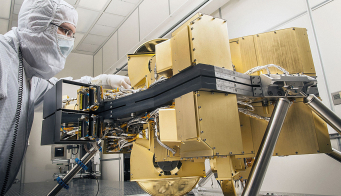
Image credit: Jon Ingall |Dreamstime.com.
The CLOUD (Cosmic Leaving OUtdoor Droplets) experiment at CERN, which is studying whether cosmic rays have a climatically significant effect on aerosols and clouds, is also tackling one of the most challenging problems in atmospheric science – understanding how new aerosol particles are formed in the atmosphere and the effect that these particles have on climate. Aerosol particles and clouds have a large net cooling effect on the planet and, according to the Intergovernmental Panel on Climate Change, they represent the largest source of uncertainty in present climate models. A new study published by CLOUD now sheds new light on the first steps of cloud formation, helping to improve our understanding of the aerosol–cloud–climate connection.
Cloud droplets form on aerosol particles – tiny solid or liquid particles suspended in the atmosphere – above a size of about 50 nm. Aerosol particles are either emitted directly into the atmosphere (like sea-spray particles) or else form by the spontaneous clustering (“nucleation”) of trace atmospheric molecules. Around one half of all cloud seeds are thought to originate from nucleated particles, but the process is poorly understood. Sulphuric acid is thought to play a key role, but previous studies by CLOUD have shown that it cannot form new particles in the lower atmosphere without another ingredient to glue the molecules together and prevent them evaporating. CLOUD recently showed one such ingredient to be a class of vapours known as amines. However, these are only found close to primary sources, such as animal husbandry, so another ingredient must be involved.
Vapours at the level of one part in 1012 control atmospheric nucleation, so it is a challenge to meet the technological requirements for studies in the laboratory. The chamber used by the CLOUD collaboration has achieved much lower concentrations of contaminants than previous experiments, allowing nucleation to be measured under atmospheric conditions for the first time without the complicating effect of undetected gases. CLOUD uses state-of-the-art instruments to measure these very low concentrations of atmospheric vapours and also to measure the chemistry and growth of newly formed molecular clusters from single molecules up to stable particles. Another unique aspect of the experiment is the capability to measure nucleation arising from ionization by cosmic rays, or from the enhanced ionization provided by a pion beam from CERN’s Proton Synchrotron – or with the effects of all ionization suppressed completely by means of a strong electric clearing field.
For the latest results, CLOUD studied particle nucleation involving the oxidation products of a volatile biogenic vapour known as alpha-pinene, which gives pine forests their familiar smell. This and similar volatile biogenic vapours are oxidized in the atmosphere to produce daughter vapours with extremely low volatility. During the past few years, numerous studies have shown the importance of these oxidized biogenic vapours for growing freshly nucleated particles to sizes where they can seed cloud droplets. However, it was not known if these oxidized biogenic vapours could provide the glue to help the first sulphuric acid molecules stick together to form embryonic particles.
Now, CLOUD has shown that oxidized biogenic vapours do form new particles with sulphuric acid and, moreover, that this process can explain a large fraction of particle formation observed in the lower atmosphere. Ions produced in the atmosphere by galactic cosmic rays are found to provide significant additional stability to the clusters, but only when the concentrations of sulphuric acid and oxidized organic vapours are relatively low.
In addition to the experimental measurements, the CLOUD team reported theoretical and global modelling studies. Quantum chemical calculations confirm the stability of the embryonic clusters of sulphuric acid and oxidized organics. Moreover, a global modelling study that includes the new nucleation mechanism has captured – for the first time – the pronounced seasonal variation of new particle production that is observed in the atmosphere. The modelling results establish that trees play a fundamental role in forming new particles in the atmosphere, which is familiar as “blue haze” when viewing distant mountains.
• The CLOUD collaboration consists of the California Institute of Technology, Carnegie Mellon University, CERN, Finnish Meteorological Institute, Helsinki Institute of Physics, Johann Wolfgang Goethe University Frankfurt, Karlsruhe Institute of Technology, Lebedev Physical Institute, Leibniz Institute for Tropospheric Research, Paul Scherrer Institute, University of Beira Interior, University of Eastern Finland, University of Helsinki, University of Innsbruck, University of Leeds, University of Lisbon, University of Manchester, University of Stockholm and University of Vienna.
Further reading
F Riccobono et al. (CLOUD collaboration) 2014 Science DOI 10.1126/science.1243527.








